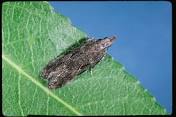Memorial Day signals a time for us to remember our fallen
heroes. It also represents the unofficial start of the summer vacation season.
 Of course, we still have a few weeks of spring left before
the arrival of the summer solstice. For growers, that means wrapping up spring
chores before the hot days of summer.
Of course, we still have a few weeks of spring left before
the arrival of the summer solstice. For growers, that means wrapping up spring
chores before the hot days of summer.
Field scout Jenna
Mayfield points out that pest monitoring will make the spring-to-summer transition
too. For example, the bug du jour moves from peach twig borer to navel
orangeworm and mites. Jenna says the cool weather, including a little rain last
Friday, kept springtime pests in check over the past week. “They don’t move
well in the rain.”
 |
| Scale on a branch. (UC IPM photo) |
Jenna points out the rain drops shouldn’t cause alarm for
almond growers – although those who also farm field crops such as tomatoes are
worried about mold. Still Jenna says growers need to keep an eye out for
diseases such as scale, which form grayish black spots on leaves, fruit and
twigs. Wind or rain will spread the spores of the fungus. Bad cases of scab
infection can cause defoliation.
To get through the spring, UC Integrated Pest Management
recommends almond growers:
- Continue monitoring for San Jose scale, navel orangeworm eggs, ant mounds and spider mites.
- Watch for diseases, including alternaria leaf spot, bacterial spot, hull rot, rust and shot hole.
- Assess for weeds.
 |
| Use a hand lends to inspect first true leaves in cotton. |
Cotton
While almonds had a head start for the growing season, cotton
plants are young and developing as the crop moves into its third month of the
season. UC IPM says growers should start sampling for aphids, spider mites and
thrips as soon as the plants emerge from the ground.
Here’s what to do:
- Sample once or twice a week.
- Walk down rows in four quadrants of the field.
- Use a hand lens to examine the first true leaves or cotyledons of random plants looking for damage and insects and mites.









